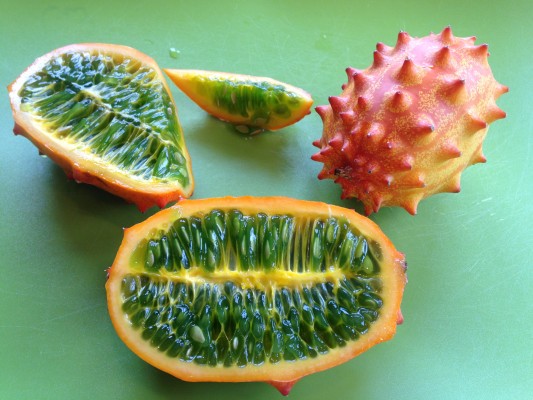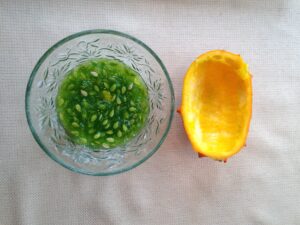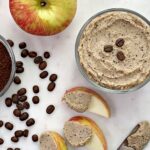
During a recent trip to the grocery store I came across an odd looking fruit that I had never seen before. I picked it up to explore further and was pricked by its spiky horns. I had never seen such a fruit and knew I needed to try it!
After taking the kiwano home and researching more I discovered many reasons why my love affair with this exotic fruit should continue.
Why I love Kiwano!
1. It has many aliases! The kiwano is also known as a:
- Horned melon
- Cucumis metuliferus
- African horned cucumber
- Jelly melon
- Hedged gourd
- Melano
- Blowfish fruit
- English tomato
2. Hangs out with a cool crowd! The kiwano is strongly associated with zucchini, melon and cucumber
3. Balanced nutrition! Low in calories and fat, contains no cholesterol or sodium and is also a good source of vitamin C and fiber! Kiwano also contains iron, zinc and magnesium.
4. It is beautiful! I love the color contrast of this fruit! I definitely did not expect to see so much color when I cut my first kiwano in half. On the outside the kiwano has little horns growing out from bright yellow and orange skin, but on the inside is a bright, lime-green jelly flesh.
 5. Anti-oxidant rich! The seeds in the melon contain the anti-oxidants a-tocopherol and y-tocopherol. Both of them are organic types of vitamin E. Vitamin E has several health advantages which includes healthy skin, heart, muscles, nerves, and red blood cells. Vitamin E likewise helps counteract harmful free-radicals that can induce long-term illnesses just like heart problems as well as cancer.
5. Anti-oxidant rich! The seeds in the melon contain the anti-oxidants a-tocopherol and y-tocopherol. Both of them are organic types of vitamin E. Vitamin E has several health advantages which includes healthy skin, heart, muscles, nerves, and red blood cells. Vitamin E likewise helps counteract harmful free-radicals that can induce long-term illnesses just like heart problems as well as cancer.
6. The color is powerful! The yellowish-green colored pigment is not only beautiful to look at, but also packed with healthy promoting properties. The yellowish-green color contains the carotenoid (anti-oxidant), beta-carotene, also known as vitamin A. Beta-carotene assists strengthen the body’s defense mechanisms and sustain eye and skin health. It may also help cancer prevention simply by suppressing the grow of free-radicals.
7. It’s great for your skin! A kiwano offers 11 mg of vitamin C. Vitamin C is essential for the generation of collagen, an element of skin tissue utilized for making as well as repairing epidermal as well as organ tissues. Additionally, it safeguards cells from injury brought on by free-radicals and harmful toxins, waste by-products of metabolism, that may result in the growth and development of disease and result in untimely aging.
8. Promotes eye health! A kiwano consists of 307 IU of vitamin A. Vitamin A is a vital nutrient for the assistance of the retina function within the eye which retains eyesight. Vitamin A additionally fortifies the strength of the mucosal lining, the very first line of protection from infection within the nasal passages, throat and also intestinal tract.
9. Great taste with many ways to enjoy! It tastes like a combination of a cucumber, kiwi and banana. As the kiwano ripens/ages the banana taste becomes stronger. To eat you can scoop out the insides and eat it right from the shell, juice it, add it to a fruit salad or cook with it. Kiwano can be a great topping for desserts like flans, cheesecakes, mousses or sundays and also perfect to garnish roasted meats.
10. The seeds are edible! Like a cucumber, the seeds of a kiwano are edible. If you were cooking with kiwano you would want to remove the seeds by pressing the interior flesh through a fine mesh sieve. The seed-free juice can be used to flavor cocktails, smoothies, dressings and sauces.



